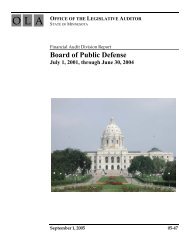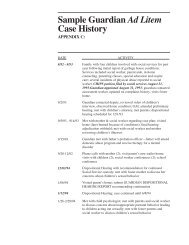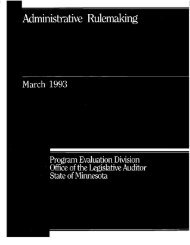Occupational Regulation - Office of the Legislative Auditor
Occupational Regulation - Office of the Legislative Auditor
Occupational Regulation - Office of the Legislative Auditor
Create successful ePaper yourself
Turn your PDF publications into a flip-book with our unique Google optimized e-Paper software.
APPENDIX B 91<br />
In this case <strong>the</strong> state proposal for a change in occupational regulation originated<br />
from a federal requirement. Prior to this federal initiative only two states<br />
regulated lead workers. 4 It is debatable whe<strong>the</strong>r <strong>the</strong> licensing <strong>of</strong> lead workers<br />
meets <strong>the</strong> criteria for regulation established in Chapter 214, especially since<br />
licensure is only required for specific lead removal projects. However, this case<br />
provides an example <strong>of</strong> how states must sometimes adjust regulatory policies in<br />
order to pre-empt federal regulation.<br />
Ano<strong>the</strong>r issued raised in this case relates to <strong>the</strong> financing <strong>of</strong> occupational<br />
regulation. The fees generated by licensing lead workers do not cover <strong>the</strong> costs <strong>of</strong><br />
regulation. The program receives some support from federal grants, but even with<br />
federal funds <strong>the</strong> licensing program is not self-supporting. This is a problem in<br />
light <strong>of</strong> Minnesota Statutes §16A.1285, which requires occupational regulation to<br />
be self supporting.<br />
MORTUARY SCIENCE PROFESSIONALS<br />
In 1994, 35 states regulated embalmers and 46 states regulated funeral directors. 5<br />
Mortuary science pr<strong>of</strong>essionals are currently regulated in Minnesota by <strong>the</strong><br />
Mortuary Science section <strong>of</strong> <strong>the</strong> Department <strong>of</strong> Health.<br />
In 1998, <strong>the</strong><br />
Health<br />
Department<br />
succeeeded in<br />
changing<br />
licensure<br />
requirements<br />
for morticians<br />
after trying to<br />
get a bill passed<br />
for three years.<br />
In 1997, H.F. 367/S.F. 199 was passed, changing <strong>the</strong> current licensing program.<br />
The legislation for morticians and embalmers included changing age and<br />
education requirements for licensees, and limiting <strong>the</strong> number <strong>of</strong> interns per<br />
license holder. This is <strong>the</strong> first major change to <strong>the</strong> statute since <strong>the</strong> 1950s, and it<br />
brings Minnesota in line with o<strong>the</strong>r states. It also accommodates people who are<br />
entering <strong>the</strong> field as a second career by giving more flexibility to education<br />
requirements. Although <strong>the</strong>re was no opposition to <strong>the</strong> bill, it was presented to <strong>the</strong><br />
Legislature for three consecutive years before it passed. Health Department staff<br />
involved in supporting <strong>the</strong> bill say <strong>the</strong> hardest part <strong>of</strong> <strong>the</strong> process was managing<br />
<strong>the</strong> bill in <strong>the</strong> Legislature.<br />
This case study illustrates how difficult and time consuming it can be to pass<br />
legislation regarding occupational regulation. The legislative process for <strong>the</strong><br />
mortuary science pr<strong>of</strong>ession took at least three years, even without any opposition.<br />
We have heard that <strong>the</strong> Legislature is more likely to pass bills that have consensus<br />
among <strong>the</strong> participants, but that did not happen <strong>the</strong> first two years mortuary<br />
science bills were introduced.<br />
Although <strong>the</strong> new statute appears to have more stringent education requirements,<br />
<strong>the</strong> department says <strong>the</strong> requirements in Minnesota mirror standards from o<strong>the</strong>r<br />
states and make it easier for people to enter <strong>the</strong> field if <strong>the</strong>y already have some<br />
education. Adjusting <strong>the</strong> requirements to match those <strong>of</strong> o<strong>the</strong>r states indicates a<br />
growing awareness <strong>of</strong> pr<strong>of</strong>essional mobility among those involved with mortuary<br />
sciences, a trend that is also affecting o<strong>the</strong>r occupations.<br />
4 Ibid.<br />
5 Ibid.








